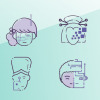Related Content
 |
Designing Data Models for Self-Documented Tests When testing applications, documenting and interpreting test results can be a challenge. Data models enable us to collect and process test data more dynamically and uniformly. To design effective data models for self-documented tests, there are three important things to consider: what to document, collect, and report. |
|
 |
Building Culturally Inclusive AI Models For us to build the most effective technology, we need to learn from our past and build our future with more comprehensive data sets with cultural intelligence. This means AI that recognizes your story, chatbots that speak to you more authentically, and smart assistants that have inclusive data about your ancestry. |
|
 |
Explaining Hardware Virtualization and Containerization Virtualization is the abstraction of a computer resource—such as hardware, memory, storage, an operating system, a desktop machine, or a network—built on top of the physical resource. There are many types of virtualization, and here, we look at virtualization of hardware and of an operating system, or containerization. |
|
 |
What’s Different about Testing Serverless Applications? Serverless computing is a DevOps technique that uses cloud-provided runtimes to execute code components in a defined workflow. Testing is easier in some ways with this model, but more difficult in others. Let's dive into the ways testing serverless applications and components is different from traditional architecture. |
|
 |
Selecting a Database for Your Data Needs Data requirements vary, and with so many different types of databases, selecting which to use can be a tricky choice. It all depends on what your database will be used for, the data structure, and the scale of data. Let’s look at six popular database types so you can decide which would be best for your situation. |
|
 |
The Advantages of Serverless Cloud Providers Most cloud providers have server-based computing services. But that requires servers to be provisioned and administered, and servers have a fixed capacity to operate within. A new DevOps trend is to go serverless—however, this doesn’t mean no servers are used at all. Learn more about this model and its advantages now. |
|
 |
4 Reasons to Use Cloud Testing for Digital Transformation Cloud computing makes data access more reliable and efficient, with less administration effort required, so testing in the cloud can accelerate your digital transformation. This helps guarantee quality and decrease time to market. Here are four more reasons to consider cloud testing for your digital transformation. |
|
 |
How Cloud Automation Can Enhance Your Business The cloud supports the automation of your business and can make things run smoother and more efficiently. It also can help manage all the different moving parts of a company. Taking a deeper dive into these benefits can help you decide if you should add the cloud to your business plans. |






